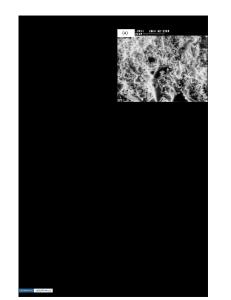Enhanced diffuse phase transition and defect mechanism of Na-doped Pb(Mg 1/3 Nb 2/3 )O 3 relaxor ferroelectrics
- PDF / 394,188 Bytes
- 11 Pages / 612 x 792 pts (letter) Page_size
- 3 Downloads / 331 Views
MATERIALS RESEARCH
Welcome
Comments
Help
Enhanced diffuse phase transition and defect mechanism of Na-doped Pb(Mg1/3 Nb2/3 )O3 relaxor ferroelectrics Kyu-Mann Lee and Hyun M. Janga) Department of Materials Science and Engineering, and Laboratory for Physical Chemistry of Dielectric Materials, Pohang University of Science and Technology (POSTECH), Pohang 790-784, Republic of Korea (Received 23 August, 1996; accepted 1 November 1996)
The diffuse phase transition (DPT) characteristics and the associated defect mechanism of Na-doped Pb(Mg1/3 Nb2/3 )O3 (PMN) relaxor perovskite were studied. The enhanced DPT and the decrease in the intensity of the superlattice reflection were observed in the presence of Na2 O. These contradictory observations were interpreted in terms of the inhibition of the growth of the 1 : 1 nonstoichiometric short-range ordered domains and the increase in the microcompositional fluctuation of the B-site cations caused by the formation of negatively charged Na 0Mg sites. The mechanism of the associated defect process was then elucidated by analyzing the electrical conductivity as a function of the oxygen partial pressure. It was shown that the substitution of Na1 ions for Mg21 ions in the B-site sublattice of perovskite PMN produced the negatively charged Na 0Mg sites with a concomitant generation of oxygen vacancies (VO?? ) for the ionic compensation. This expedites the enhancement of the compositional inhomogeneities of the B-site cations and suppresses the growth of the nonstoichiometrically ordered nanodomains in a disordered matrix.
I. INTRODUCTION
Pb(Mg1/3 Nb2/3 )O3 (referred to as PMN) is the most extensively studied Pb(B01/3 B002/3 )O3 -type relaxor material which undergoes a diffuse phase transition over a broad temperature range.1,2 This material is characterized by large dielectric permittivity with a broad ferroelectric transition near room temperature, low firing temperatures, and low operating voltages, coupled with a small electromechanical hysteresis. These make it one of the most attractive materials for multilayer ceramic capacitors (MLCC)3 and electrostrictive actuators.4–6 Although the polarization-related electrostrictive coefficients (Q) of PMN-based relaxors are one order of magnitude smaller than those of simple ordered perovskites, large values of the electrostrictive strain and the dielectric capacitance can be induced by virtue of the unusually large permittivity values of PMN-based relaxors.7 Thus, they were successfully applied to the fabrication of various modern microactuating devices such as deformable mirrors and bistable optical devices.4,8 However, due to strong temperature-dependent dielectric permittivities of PMN-based systems, their applications to precision displacement transducers and multilayer ceramic capacitors are limited.9,10 Two approaches for improving the thermostability of a)
Author to whom correspondence should be addressed.
1614
http://journals.cambridge.org
J. Mater. Res., Vol. 12, No. 6, Jun 1997
Downloaded: 27 Mar 2015
electrostrict
Data Loading...











